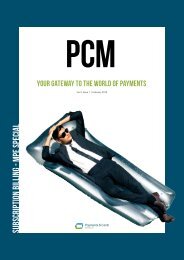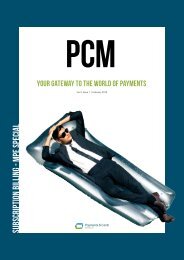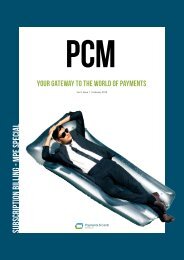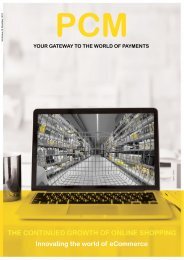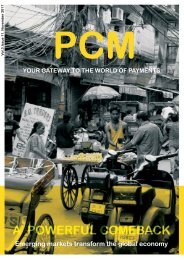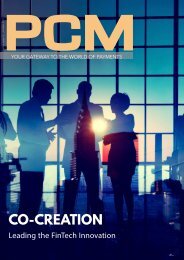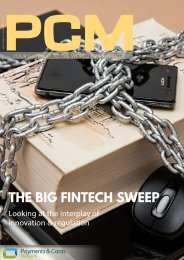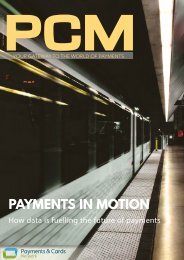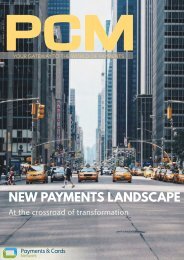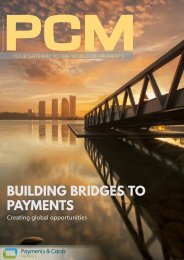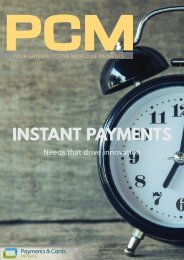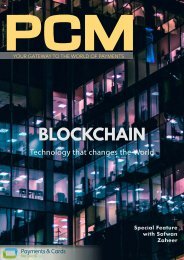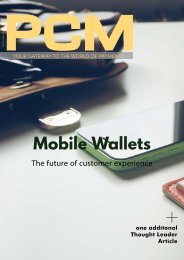PCM Vol.2 - Issue 6
Create successful ePaper yourself
Turn your PDF publications into a flip-book with our unique Google optimized e-Paper software.
startup spotlight<br />
latest to the game but we do use the latest technology that<br />
others weren’t using a couple of years ago.<br />
As the technical landscape is undergoing continuous change<br />
and innovation, we always try to be at the vanguard of that<br />
front. So, with more than half of the Risk Ident team being<br />
either data scientists or software engineers we focus mainly<br />
on a continuously evolving product that strongly benefits from<br />
the latest technology.<br />
Where does Risk Ident stand now and what’s on the<br />
horizon for the company?<br />
We currently have 50 clients which are mostly big enterprises.<br />
Our client group includes some of the biggest mobile network<br />
operators, big ecommerce stores (with at least 100-200 Million<br />
Euro annual turnover) Fintech companies as well as banks.<br />
I think we have a strong position in the German speaking<br />
markets and therefore have become one of the leaders on<br />
our home domain. We just started to venture into additional<br />
European market and at the beginning of next year we’ll also<br />
be operating in the US.<br />
Putting it into a startup environment perspective you<br />
commonly need three essential components to become<br />
successful. These include having a great team, building<br />
excellent products and eventually selling it to real clients. We<br />
have accomplished and gathered these vital startup elements<br />
and now it’s all about how to scale up our business. Moreover,<br />
we do target only larger companies who can use our tools to<br />
enhance their fraud protection.<br />
More importantly we realized that it doesn’t matter if<br />
we sell to a big German e-commerce player, a UK based<br />
telecommunication company or an US travel portal because<br />
many fraud cases are very similar in the way fraudsters<br />
operate. One of our advantage is that the tools we built<br />
are very agnostic to the market and will also work for other<br />
markets. The only thing we have to do is to train the tools<br />
with different data. For that reasons I’d say that we have good<br />
chances to expand to new markets on a global scale.<br />
In your experience of fraudulent transactions, what is the<br />
most common source of fraud?<br />
When talking about online retail there are two main aspects<br />
about fraud. On the one hand, there is the single fraud cases<br />
in which commonly people with bad credit score try to obtain<br />
goods. You can usually identify them by behavioral actions<br />
like changing their name or address and they try to get one<br />
product or service. In contrast to that there is the very harmful<br />
organized fraud. These people are very professional and<br />
oftentimes even do that illegal activities for a living. What is<br />
more, they don’t stop at e-commerce fraud alone, they would<br />
try to get to other people’s online loans or similar personal<br />
account information. Another fact why organized fraud is<br />
considered a lot more harmful than single fraud cases is that<br />
with the increasing number of fraud cases, the risk to have full<br />
complete loss scales up. Unfortunately, the trend of organized<br />
fraud is becoming stronger right now. In conclusion organized<br />
fraudulent activities represent the bigger problem and risk<br />
for the merchants.<br />
Will upcoming regulations in Europe influence Risk Ident’s<br />
business, and how?<br />
Our main advantage in this regard is that our fraud prevention<br />
software can be installed on premise. That’s very handy when<br />
we talk with banks for instance, as they are working with very<br />
sensitive customer information which banks won’t share with<br />
third parties. And even the large e-commerce customers with<br />
the big data breaches that happened throughout the last years<br />
they were very reluctant to hand out their end costumer data<br />
to a third party. When working with our software the clients<br />
can install and integrate it on premise and they can train it with<br />
its data without sending out a single customer information.<br />
That is an immense value we can offer in comparison to other<br />
anti-fraud solution provider. In that light regulations are not a<br />
major challenge for us to overcome.<br />
How do you teach a machine to get smarter at identifying<br />
fraud?<br />
In the light of machine learning there is one major<br />
misconception. Many people say that their machine learning<br />
component of their product is like a secret ingredient. I think<br />
that the machine learning algorithm you use is not the main<br />
advantage. There are many rather simple algorithms that can<br />
be very good, such as Random Forest, Naive Bayes or Logistic<br />
Regression. However, there are two things which are more<br />
important than the machine learning component. First of all,<br />
it’s about the type of data you feed in – when feeding in lowquality<br />
data then you can only expect poor results. The other<br />
vital aspect is how to scale a machine learning system on a<br />
production level in terms of amount of data and response<br />
times. That’s why Risk Ident is very transparent about our<br />
machine learning components and sometimes we even tell<br />
our customers which specific set of algorithms we use on their<br />
data because we know how hard it is to provide it on a stable<br />
productive software solution and you need to know what you<br />
put in. The machine algorithm typically will only understand<br />
numbers, so you have to get your data pre-processed also<br />
017





